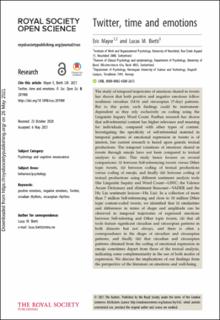| dc.description.abstract | The study of temporal trajectories of emotions shared in tweets has shown that both positive and negative emotions follow nonlinear circadian (24 h) and circaseptan (7-day) patterns. But to this point, such findings could be instrument-dependent as they rely exclusively on coding using the Linguistic Inquiry Word Count. Further, research has shown that self-referential content has higher relevance and meaning for individuals, compared with other types of content. Investigating the specificity of self-referential material in temporal patterns of emotional expression in tweets is of interest, but current research is based upon generic textual productions. The temporal variations of emotions shared in tweets through emojis have not been compared to textual analyses to date. This study hence focuses on several comparisons: (i) between Self-referencing tweets versus Other topic tweets, (ii) between coding of textual productions versus coding of emojis, and finally (iii) between coding of textual productions using different sentiment analysis tools (the Linguistic Inquiry and Word Count—LIWC; the Valence Aware Dictionary and sEntiment Reasoner—VADER and the Hu Liu sentiment lexicon—Hu Liu). In a collection of more than 7 million Self-referencing and close to 18 million Other topic content-coded tweets, we identified that (i) similarities and differences in terms of shape and amplitude can be observed in temporal trajectories of expressed emotions between Self-referring and Other topic tweets, (ii) that all tools feature significant circadian and circaseptan patterns in both datasets but not always, and there is often a correspondence in the shape of circadian and circaseptan patterns, and finally (iii) that circadian and circaseptan patterns obtained from the coding of emotional expression in emojis sometimes depart from those of the textual analysis, indicating some complementarity in the use of both modes of expression. We discuss the implications of our findings from the perspective of the literature on emotions and well-being. | en_US |

